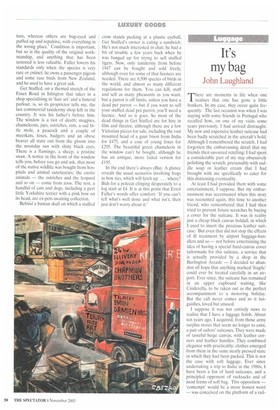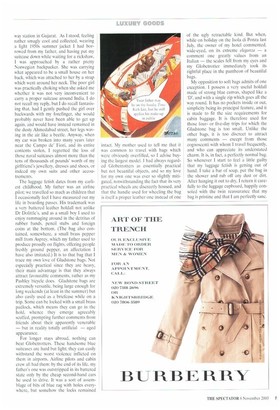It's my bag
John Laughland
There are moments in life when one realises that one has gone a little bonkers. In my case, they occur quite frequently. The last occasion was when I was staying with some friends in Portugal who recalled how, on one of my visits some years previously, I had arrived distraught. My new and expensive leather suitcase had been badly scratched in the aircraft's hold. Although I remembered the scratch, I had forgotten the embarrassing detail that my friends then savoured retelling: I had spent a considerable part of my stay obsessively polishing the scratch, presumably with saddle soap or leather cream that I had brought with me specifically to cater for this distressing eventuality. At least [had provided them with some entertainment, I suppose. But my embarrassment was accentuated when this story was recounted again, this time to another friend, who remembered that I had then tried to prevent future scratches by buying a cover for the suitcase. It was in reality just a cheap black canvas holdall, in which I used to insert the precious leather suitcase. But even that did not stop the effects of ill treatment by airport baggage-handlers and so — not before entertaining the idea of having a special hard-canvas cover tailormade for this suitcase, a service that is actually provided by a shop in the Burlington Arcade — I decided to abandon all hope that anything marked 'fragile' could ever be treated carefully in an airport. Ever since, the suitcase has remained in an upper cupboard waiting, like Cinderella, to be taken out as the perfect accompaniment to a motoring holiday. But the call never comes and so it languishes, loved but unused.
I suppose it was not entirely news to realise that I have a luggage fetish. About ten years ago, I acquired, from those army surplus stores that seem no longer to exist, a pair of sailors' suitcases. They were made of tasteful beige canvas, with leather corners and leather handles. They combined elegance with practicality: clothes emerged from them in the same neatly pressed state in which they had been packed. This is not the case with soft luggage. Ever since undertaking a trip to India in the 1980s, I have been a fan of hard suitcases, and a principled opponent of rucksacks and of most forms of soft bag. This opposition — 'contempt' would be a more honest word — was conceived on the platform of a rail way station in Gujarat. As I stood, feeling rather smugly cool and collected, wearing a light 1950s summer jacket I had borrowed from my father, and having put my suitcase down while waiting for a rickshaw, I was approached by a rather pretty Norwegian backpacker. She was carrying what appeared to be a small house on her back, which was attached to her by a strap which went around her neck. The poor girl was practically choking when she asked me whether it was not very inconvenient to carry a proper suitcase around India. I do not recall my reply, but I do recall fantasising that, had I gently pushed the girl over backwards with my forefinger, she would probably never have been able to get up again, and would have instead remained in the dusty Ahmedabad street, her legs waving in the air like a beetle. Anyway, when my car was broken into many years later near the Campo de' Fiori, and its entire contents stolen, I regretted the loss of those naval suitcases almost more than the tens of thousands of pounds' worth of my girlfriend's jewellery, dresses and shoes, or indeed my own suits and other accoutrements.
The luggage fetish dates from my earliest childhood. My father was an airline pilot; we travelled so much as children that I occasionally feel I have measured Out my life in boarding passes. His trademark was a very battered leather holdall not unlike Dr Dolittle's, and as a small boy I used to enjoy rummaging around in the detritus of rubber bands, pencil stubs and foreign coins at the bottom. (The bag also contained, somewhere, a small brass pepper mill from Asprey, which my father used to produce proudly on flights, offering people freshly ground pepper, an affectation I have also imitated.) It is to that bag that I trace my own love of Gladstone bags. Not especially practical since they are heavy, their main advantage is that they always attract favourable comments, rather as my Pashley bicycle does. Gladstone bags are extremely versatile, being large enough for long weekends (at least in the summer) but also easily used as a briefcase while on a trip. Some can be locked with a small brass padlock, which means they can go in the hold, whence they emerge agreeably scuffed, prompting further comments from friends about their apparently venerable — but in reality totally artificial — aged appearance.
For longer stays abroad, nothing can beat Globetrotters. These handsome blue suitcases are hard but light; they can easily withstand the worst violence inflicted on them in airports. Airline pilots and cabin crew all had them: by the end of its life, my father's one was outstripped in its battered state only by the cheap second-hand cars he used to drive. It was a sort of assemblage of bits of blue rag with holes everywhere, but somehow the locks remained intact, My mother used to tell me that it was common to travel with bags which were obviously overfilled, so I advise buying the largest model. I had always regarded Globetrotters as essentially practical but not beautiful objects, and so my love for my own one was ever so slightly mitigated, notwithstanding the fact that its very practical wheels are discreetly housed, and that the handle used for wheeling the bag is itself a proper leather one instead of one
of the ugly retractable kind. But when, while on holiday on the Isola di Ponza last July, the owner of my hotel commented, wide-eyed, on its extreme eleganza — a comment one greatly values from an Italian — the scales fell from my eyes and my Globetrotter immediately took its rightful place in the pantheon of beautiful bags.
My opposition to soft bags admits of one exception. I possess a very useful holdall made of strong blue canvas, shaped like a `D', and with a single zip which goes all the way round. It has no pockets inside or out, simplicity being its principal feature, and it is made to fit the size requirements for cabin baggage. It is therefore used for those fouror five-day trips for which the Gladstone bag is too small. Unlike the other bags, it is too discreet to attract many comments — except from those cognoscenti with whom I travel frequently, and who can appreciate its understated charm. It is, in fact, a perfectly normal bag. So whenever I start to feel a little guilty that my luggage fetish is getting out of hand, I take a bar of soap, put the bag in the shower and rub off any dust or dirt. After hanging it out to dry, I return it carefully to the luggage cupboard, happily consoled with the twin reassurance that my bag is pristine and that I am perfectly sane.



































































































 Previous page
Previous page